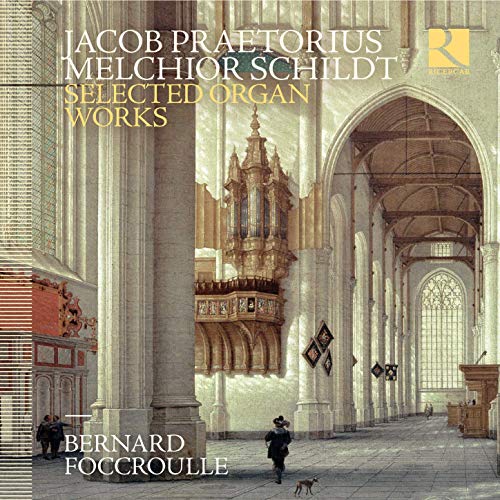Organ music & vocal works by Buxtehude, Hassler, Praetorius & Scheidemann
Kei Koito, Il canto d’Orfeo, Gianluca Capuano
73:15
deutsche harmonia mundi 889854 376727
+Böhm, Decius, Decker, Goudimel, J. Praetorius the younger, Joh. Praetorius?, M. Praetorius, Stadlmayr, Tunder, Weckmann & anon
[dropcap]T[/dropcap]his splendid and beautifully recorded CD is a tribute to its engineers as well as to the artists who chose and performed such interesting and well-researched music. This is the best tribute to this year’s Lutheran celebrations that I have heard, and it captures the richness of the interplay between the outstanding Hans Scherer organ of St Stephanskirche in Tangermünde and the chorales, motets and Gregorian chant sung by the Italian group, Il Canto di Orfeo, whose contributions were recorded in a sacristy in Milan. Try the amazing organum on track 17 as a taster!
As in her Bach Vol. 5, recorded equally well on the Volkland organ in the Cruciskirche in Erfurt, the choice of instrument seems exactly right for this music. Like the Erfurt organ, this remarkable survival of the 1624 Hans Scherer organ was reconstituted by Alexander Schuke of Potsdam and is tuned pretty mean at 486hz. She draws attention to the remarkable 8’ Pedal Octavenbaß and we hear it used on its own, where it has the clarity and dignity of a G violone at the bottom of an early Baroque instrumental ensemble as well as providing a rich fullness to the pedal organ in combination with the Untersatz or the Bassunenbaß. The manual reeds on the Oberpositiff are colourful, the OberWerke is based on the 16’ principal, and its mixtures are related to that pitch. It seems possible to combine ranks in almost any combination, and her choice of registration lets us hear the variety as well as the depth of this almost unique survival of its period and place.
As her helpful notes – you need to check the English version with the German when it seems peculiar – disclose, the connections between the composers represented and the socio-cultural as well as musical worlds that they inhabited is remarkably complex. She lists which composers’ works are found in which libraries, and the relatively brief notes (nine pages) are full of detailed information and further references. As in her other recent recordings, only the specification is given in the booklet, but the detailed registration is provided in full on her website, to which the booklet refers.
I enjoyed the artistry, the planning of the programme, the collaboration with the Italian OVPP group, the beautifully recorded organ and its colourful registers in equal measure. This is a well-thought-out, and very musical programme, performed with great skill. The sounds are exciting, and the overall concept is excellent. I cannot commend it too highly.
David Stancliffe
[dropcap]T[/dropcap]here are two stars on this recording, the player and the instrument. Right from the first bars of the opening Tunder Praeludium the full sound of this stunning organ, expertly recorded here, shines through with the splendour of the disc’s title. The instrument is the early 17th-century Hans Scherer organ in the Stephanskirche in Tangermünde, restored in 1994 by Alexander Schuke. Koito follows the Tunder with Buxtehude’s Nun komm der Heiden Heiland played on flutes which immediately shows the quieter side of the organ. The rest of the programme is chosen to showcase it in music by Hieronymous and Jacob Praetorius, Scheidemann, Weckmann and Böhm. There is lots of antiphonal playing which contrasts various stop combinations, while the meantone tuning and beautifully-even voicing make it a joy to listen to. Koito’s playing matches the brilliance of the organ with fluent and unforced phrasing, enhanced by intelligently-applied ornamentation. The organ music is interspersed with chorale settings by earlier German composers like Hassler and Michael Praetorius and with some plainchant. As on Koito’s other recordings, the gaps between tracks are minimised which helps the flow between them. Continuity is also helped by particular groupings of tracks around successive verses of the Magnificat (though unfortunately only one verset from Weckmann’s organ set is included) and the German Vater unser. The vocal tracks are sung by Il Canto di Orfeo and are mostly of a suitable brightness to match the organ. There is some anomalous Solesmes-style plainchant, and parallel-fifth organum, but generally the match between organ and singing works well. Koito has written her own very helpful liner notes and there is more comprehensive information about registrations, texts and translations, biographies on her website at http://www.kei-koito.com/. This is a most impressive recording indeed which makes a compelling case for the importance of the North German organ and its repertoire.
Noel O’Regan
[iframe style=”width:120px;height:240px;” marginwidth=”0″ marginheight=”0″ scrolling=”no” frameborder=”0″ src=”//ws-eu.amazon-adsystem.com/widgets/q?ServiceVersion=20070822&OneJS=1&Operation=GetAdHtml&MarketPlace=GB&source=ss&ref=as_ss_li_til&ad_type=product_link&tracking_id=infocentral-21&marketplace=amazon®ion=GB&placement=B072L7J3NW&asins=B072L7J3NW&linkId=0a9145e54c37d08dd1e2ba852bdeb0c4&show_border=true&link_opens_in_new_window=true”]
[iframe src=”http://www.jpc-partner.de/link.php?partner=ngr&artnum=7048853&bg=ffffff&tc=000000&lc=e5671d&s=120&t=1&i=1&b=1″ width=”120″ height=”214″ scrolling=”no” frameborder=”0″]
[iframe style=”width:120px;height:240px;” marginwidth=”0″ marginheight=”0″ scrolling=”no” frameborder=”0″ src=”//ws-na.amazon-adsystem.com/widgets/q?ServiceVersion=20070822&OneJS=1&Operation=GetAdHtml&MarketPlace=US&source=ss&ref=as_ss_li_til&ad_type=product_link&tracking_id=earlymusicrev-20&marketplace=amazon®ion=US&placement=B072L7J3NW&asins=B072L7J3NW&linkId=51dca0e1bf78a03cd841ce30d81a49e1&show_border=true&link_opens_in_new_window=true”]



